Coxarthrosis of the hip joint is a degenerative-dystrophic process occurring in the articular joint of the femoral head and the acetabulum of the pelvis. The disease is more characteristic of middle-aged and elderly people, although it can occur in young people, including children. Often, its development occurs before injuries, as well as a number of inflammatory and non-inflammatory pathologies, and pain and stiffness of movements become the main symptoms of the degenerative-dystrophic process in the hip joint. In its development, the disease goes through several stages, and if it can be treated conservatively in the early stages, the treatment of coxarthrosis of the hip joints in the last stages is effective only surgically. Otherwise, the pathology will cause serious disorders or even complete immobilization.
What is coxarthrosis of the hip joint and the mechanism of its development
Coxarthrosis, also called osteoarthritis and deforming arthrosis, is a complex disease of the hip joints (HJ) with progressive cartilage destruction. Over time, this leads to deformation of the surfaces of adjacent bones, as well as the formation of bone growths called osteophytes.
The two hip joints are the largest joints in the body. Each of them originates from the acetabulum of the femur and pelvis. The head of the femur is located in the cup-like recess of the pelvis and moves freely in different directions. This structure of the joint allows flexion and extension, adduction and abduction, and rotation of the thigh.
So that movement does not cause discomfort, the touching surfaces of the bones are covered with an elastic layer called hyaline cartilage. It is what allows the femoral head to slide easily in the acetabulum. Also, hyaline cartilage provides stabilization and cushioning of the hip joint during movements.
The entire joint is encased in a kind of case called the articular capsule. It contains a synovial membrane that synthesizes synovial fluid. It is the one that lubricates the surface of the cartilage, ensures that water and nutrients enter it, that is, it is responsible for maintaining the normal structure of the cartilage tissue.
Above the joint capsule there is a group of thigh and pelvic muscles, with their help the joint is moved. The hip joint is also surrounded by a group of ligaments that ensure stability of its position within physiological limits.
Since the hip joint is exposed to heavy loads every day, it is prone to wear and tear. The risk of such changes significantly increases the impact of a number of unfavorable factors that are practically unavoidable in the modern world, but they will be discussed below. This explains the high prevalence of coxarthrosis.
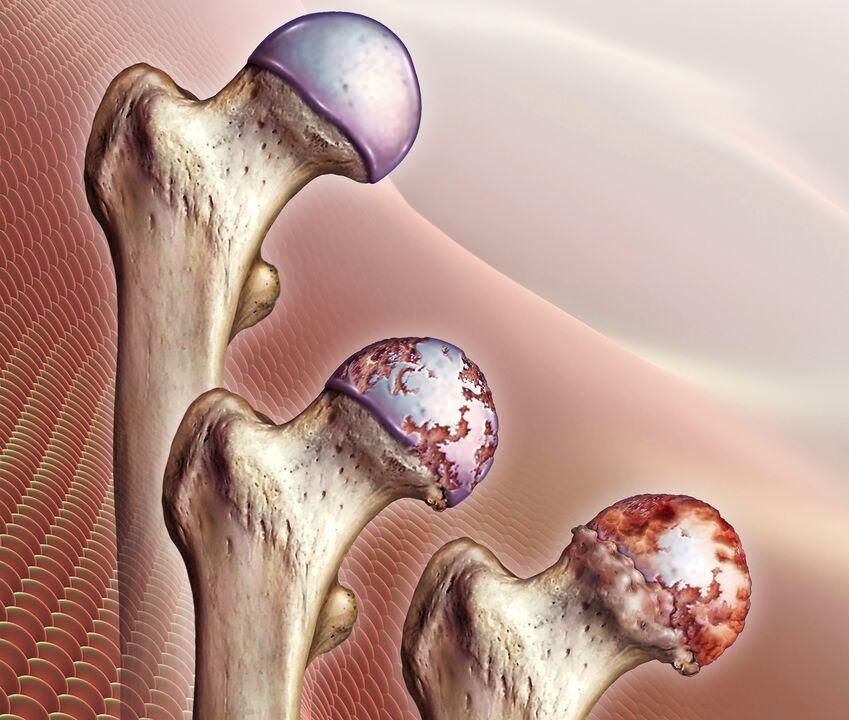
As a result of the influence of negative factors, there is a violation of the production of synovial fluid. Gradually, its quantity decreases and its quality also changes: it becomes viscous, thick and can no longer fully nourish the cartilage. This leads to acute malnutrition and progressive dehydration of the hyaline cartilage. As a result of such changes, the strength and elasticity of the cartilage tissue decreases, wears, cracks and decreases in volume. All this prevents smooth sliding of the femoral head in the acetabulum of the pelvic bone, which leads to the appearance of symptoms of hip coxarthrosis.
Gradually, the inter-articular space narrows, there is increased friction between the articular bone surfaces, and the pressure of the bones on the hyaline cartilage increases. This leads to even greater damage and wear and tear, which cannot but affect the biomechanics of the hip joint and the well-being of the individual.
As the pathological changes progress, the hyaline layer gradually completely disappears, which leads to the exposure of the bone surfaces and a critical increase in the load on the bone joint. During movements, the femoral head is no longer covered by anything and rubs directly against the surface of the pelvic acetabulum. In addition to severely restricting mobility and causing excruciating pain, the bones are pressed together and flattened at the same time.
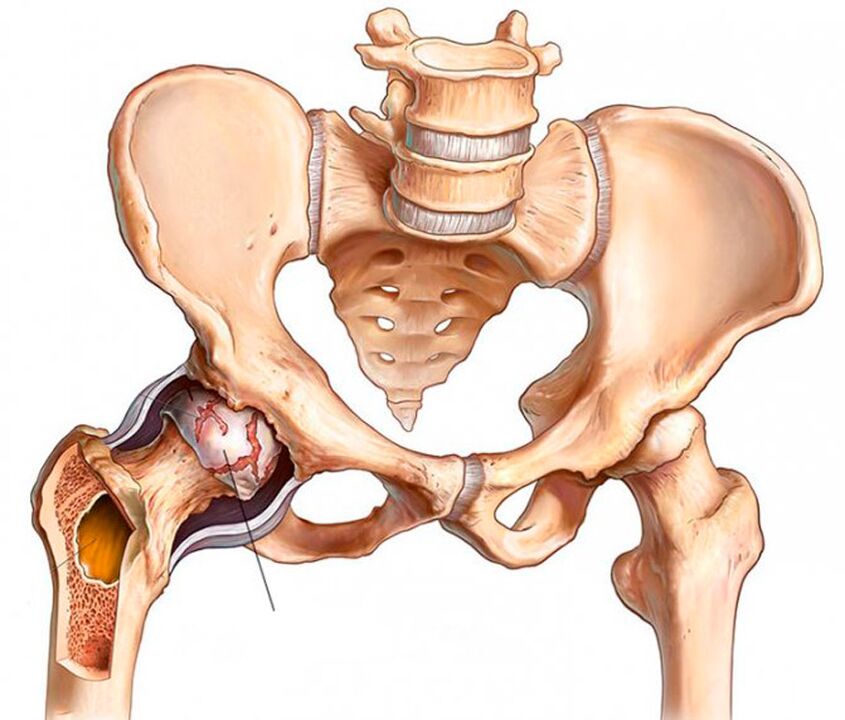
As the articular bones are deformed, bone protrusions (osteophytes) are formed on their surface. They can have sharp edges and can seriously injure the surrounding muscles. This causes severe pain in the groin, legs and hips. Therefore, the patient unconsciously tries to protect the affected hip joint and avoid movements in it. Lack of adequate load on the muscles leads to their gradual atrophy, which further increases mobility problems. This results in lameness.
Reasons for development
Coxarthrosis of the hip joint can be primary or secondary. In the first case, it is impossible to find the reasons for its development, that is, the disease develops on its own without any reason. Secondary coxarthrosis is the result of a number of changes in the state of the musculoskeletal system or lifestyle characteristics, in particular:
- injuries of the hip joint, including bone fractures, sprains, bruises, tears or ruptures of surrounding ligaments, chronic microdamages, etc. ;
- tiring physical work;
- sedentary lifestyle;
- obesity;
- chronic infectious processes in the body;
- rheumatoid arthritis, gout, tendonitis, bursitis;
- endocrine diseases, metabolic and hormonal disorders, including diabetes mellitus;
- congenital defects of the hip joint (dislocation, dysplasia);
- aseptic necrosis of the femoral head;
- various types of spinal pathologies;
- genetic predisposition;
- smoking addiction.
In most cases, the development of coxarthrosis of the hip joint is associated with inevitable age-related changes, and the presence of other factors from the above only increases the risk of its occurrence and increases the rate of progression.
Symptoms and rates
During coxarthrosis, 4 degrees of development are distinguished, of which 1 is the easiest. At first, the disease may be asymptomatic or manifest as mild pain. More often they occur from strong physical exertion, a long walk or at the end of a busy day. In the early stages of the disease, anxiety is usually associated with fatigue and is considered the norm. Therefore, in extremely rare cases, coxarthrosis of the hip joint is diagnosed at the 1st stage of development.
Perceptible signs of coxarthrosis begin to appear in the 2nd stage of its progression, when the joint cavity is almost halved and the femoral head is displaced and deformed. With the transition to the 3rd stage, the pain becomes unbearable and can bother a person even at night, and tends to radiate to the hip, calf, groin and hip areas. Since the joint space is practically non-existent and many osteophytes are formed on the bone surfaces, independent movement is impossible in such situations. Therefore, patients are forced to use canes or crutches.

Thus, the main symptoms of coxarthrosis of the hip joint are:
- Mobility limitations - at first, patients may notice the appearance of difficulties in performing rotation movements of the leg, but over time, morning stiffness and swelling of the HJ join them. Because of them, a person needs a few minutes to warm up and walk around, so to speak, to regain normal range of motion. Gradually, it becomes more and more difficult for the patient to perform leg movements.
- A characteristic crisis - occurs during walking, as well as during flexion or extension of the hip joint. This is the result of bone surfaces rubbing against each other and is accompanied by sharp or dull pain with coxarthrosis.
- Pain syndrome - at first, pain occurs after physical exertion and decreases slightly after a long rest. An acute attack can be provoked by weight lifting or hypothermia, because coxarthrosis is often complicated by the addition of inflammation of the synovial membrane. As the disease progresses, the pain becomes more frequent, lasts longer, and worsens.
- Spasm of the thigh muscles is the result of compression of the nerves and weakening of the ligamentous apparatus, so the spasm of the muscles is compensated to keep the head of the femur in the acetabulum. Also, muscle spasm can be provoked by the addition of synovitis.
- Lameness - occurs in the last stages of the development of the disease, because the deformation of the bone surfaces provokes the appearance of contracture of the flexor muscles. Therefore, a person cannot fully straighten his leg and keep it in this position. Also, the patient may involuntarily limp to shift his weight to the healthy half of the body, as this helps reduce the intensity of the pain.
- Shortening of the leg - observed with 3rd degree coxarthrosis. The leg on the side of the affected hip joint may shorten by 1 cm or more due to narrowing of the joint space, decreased muscle tone, and flattening of the femoral head.
At the same time, degenerative-dystrophic changes can be observed in one or both hip joints. Accordingly, the characteristic symptoms will be observed either on one side or on both at the same time, but in the second case, their severity may be different on the left and right.
Diagnostics
Based on the patient's complaints, external examination and the results of functional tests, the doctor may suspect the presence of coxarthrosis of the hip joint. Be sure to measure the length of the legs during the visual inspection. For this, the patient is asked to stand up and straighten his legs as much as possible. The measurement is taken between the front axis of the pelvis and any bony structure of the knee, ankle or heel. However, if both hip joints are simultaneously affected by coxarthrosis, the data obtained will be uninformative.
However, since the symptoms characteristic of coxarthrosis can be accompanied by a number of other inflammatory and non-inflammatory diseases, instrumental examination methods are mandatory for the patient to accurately diagnose the pathology. Can be:
- CT or X-ray of the hip joint - images show destructive changes, narrowing of the joint space, formation of osteophytes and deformation of bone surfaces;
- MRI is the most informative examination method that allows to accurately assess the nature of changes in cartilage structures, ligaments and the nature of blood circulation in the thigh area.
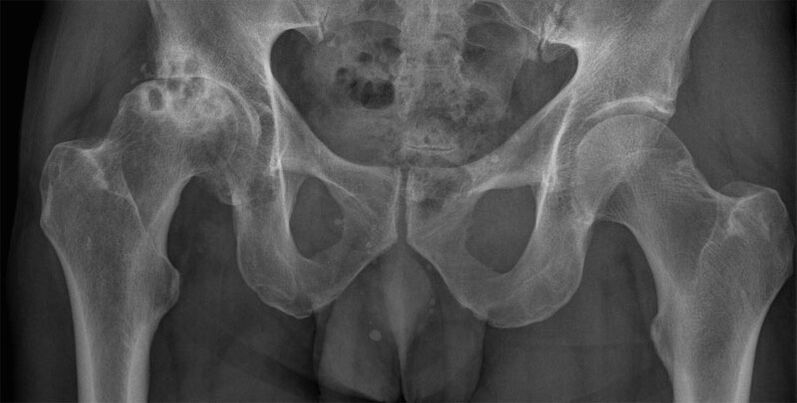
Patients are also prescribed laboratory tests to assess their general health and detect diseases that may cause coxarthrosis. He:
- UAC and OAM;
- blood chemistry;
- rheumatic tests;
- puncture of the hip joint with a biochemical study.
The task of diagnosis is to distinguish hip coxarthrosis from gonarthrosis (knee joint damage), as well as radicular syndrome occurring with osteochondrosis, as well as protrusions and tears of intervertebral discs. Also, the symptoms of coxarthrosis are similar to the manifestations of trochanteric bursitis and an atypical course of ankylosing spondylitis, which requires a full examination to find the real causes of pain and movement limitations.
Conservative treatment
Conservative treatment of hip coxarthrosis is effective only in the early stages of the disease. It is chosen individually for each patient and may include a number of different methods, each of which will complement the others. Therefore, as part of the treatment of coxarthrosis of the hip joint, patients can be prescribed:
- drug treatment;
- exercise therapy;
- physiotherapy;
- plasmolifting.
For conservative treatment to be effective, patients must eliminate the influence of a number of factors that contribute to the development of hip coxarthrosis. If you are overweight, it is very important to reduce it as much as possible. This will reduce the load on the affected joint and the risk of developing a degenerative-dystrophic process.

You should also give up smoking and normalize your physical activity regime, avoid overexertion, but don't sit all the time. It is recommended to wear special bandages and orthoses to prevent further destruction of the hip joint. They provide secure fixation of the joint and support it during movement.
Treatment
The nature of drug therapy is chosen strictly individually. In most cases, patients are prescribed:
- NSAIDs - drugs with simultaneous analgesic and anti-inflammatory effects (available in the form of tablets, injections and local agents);
- corticosteroids - drugs with a strong anti-inflammatory effect, prescribed when NSAIDs do not have an obvious effect;
- chondroprotectors - help to activate cartilage tissue regeneration processes, but their effectiveness has not been proven;
- muscle relaxants - drugs that reduce muscle tone and eliminate spasms, which are necessary during spasm of certain muscles or groups against the background of severe pain;
- drugs to improve blood circulation - most often used in the form of injection solutions and help to improve the trophism of tissues around the joint;
- group B vitamins - shown to normalize the transmission of nerve impulses, which is especially important when nerves are compressed by deformed bone structures.
Intra-articular or peri-articular blockades can be applied to patients for acute pain that cannot be relieved with the help of tablets. They are performed only by qualified medical personnel in a medical facility and involve the injection of anesthetic solutions with corticosteroids into the joint cavity or the area directly around it.
exercise therapy
Therapeutic exercise is an effective way to combat decreased muscle tone and limited mobility. Thanks to a properly selected set of exercises, it is possible to increase the range of motion and reduce the severity of pain. They also prevent muscle atrophy, and if coxarthrosis is accompanied by compression of nerve fibers, this reflexively helps to eliminate spasms that cause individual muscle spasms.
Exercise therapy classes can improve blood circulation in the area of the degenerative-dystrophic process. Thanks to this, the quality of trophism of the diseased joint increases and the course of regenerative processes accelerates.

A set of exercises should be prepared individually by a specialist for each patient. At the same time, not only the degree of destruction of the hip joint, but also the level of physical development of the patient is taken into account.
Physiotherapy
Physiotherapy procedures and massage have an anti-inflammatory, analgesic, tonic, anti-edema effect. In addition, they help maintain normal leg muscle tone, prevent their atony and atrophy.
With coxarthrosis of the hip joint, courses of 10-15 procedures are prescribed:
- ultrasound therapy;
- magnetotherapy;
- laser therapy;
- electrophoresis;
- ultraphonophoresis;
- UHF;
- paraffin treatment.
Also, mud therapy is offered to many patients. Such procedures have a positive effect only in the 1st stage of the development of coxarthrosis of the hip joint or during rehabilitation after surgical treatment. Thanks to the healing mud, it is possible to improve the quality of blood circulation and accelerate the recovery of the motor capabilities of the affected joint.
Plasmolifting
Plasmolifting or PRP-therapy is a procedure that involves injecting the patient's own blood platelet-rich plasma into the cavity of the hip joint. This allows you to activate the regeneration processes of hyaline cartilage.
However, according to some scientists, such a procedure can lead to the formation of malignant tumors. This point of view is based on the fact that plasmolifting promotes the formation of a large number of stem cells, the effects of which have not yet been fully studied.
Surgical treatment of hip joint coxarthrosis
Despite significant problems in the hip joint, many consult a doctor too late, when pathological changes in the joint reach 3 or even 4 degrees of severity and the functionality is irreversibly depleted.
With advanced pathology, surgery is a necessary measure. Only timely surgical intervention will help restore normal mobility and save the patient from unbearable pain, that is, achieve a significant improvement in the quality of human life. No drugs, physiotherapeutic procedures can restore seriously destroyed cartilage. At best, painful intra-articular injections and medications can reduce the pain. But this will be a temporary phenomenon, after which the pain will return again with the same or greater force.
Indications for hip surgery are:
- disappearance of the interarticular space;
- constant pain in the hip joint, not suitable for relief;
- critical mobility disorders;
- hip fracture.
Depending on the severity of joint destruction and bone deformation, patients may be offered different types of surgical treatment, namely:
- arthrodesis;
- endoprosthesis;
- osteotomy.
Arthrodesis
Arthrodesis is a convenient operation that involves strong fixation of joint bones with metal plates. The result is complete immobilization of the joint. Therefore, with the help of arthrodesis, it is only possible to correct the supporting function of the leg, relieve pain, but it is not necessary to talk about restoring mobility or significantly improving the quality of life.
Endoprostheses
Endoprosthetics with arthroplasty is the only way to fundamentally solve the problem of coxarthrosis of the hip joint by restoring all its functions and motor capabilities. This is a high-tech method of solving the problem of coxarthrosis, which allows you to completely forget about pain and mobility restrictions for 15-30 years. Thanks to the use of modern endoprostheses, it is possible to achieve full recovery of motor support functions and ensure the patient's normal lifestyle.
The operation involves resection of the femoral head and part of its neck. Surgical preparation of the acetabular bed is also performed, which includes removal of osteophytes, alignment of the surface, and resection of necrotic tissues. Endoprosthetics can even be used to treat elderly patients with hip coxarthrosis.
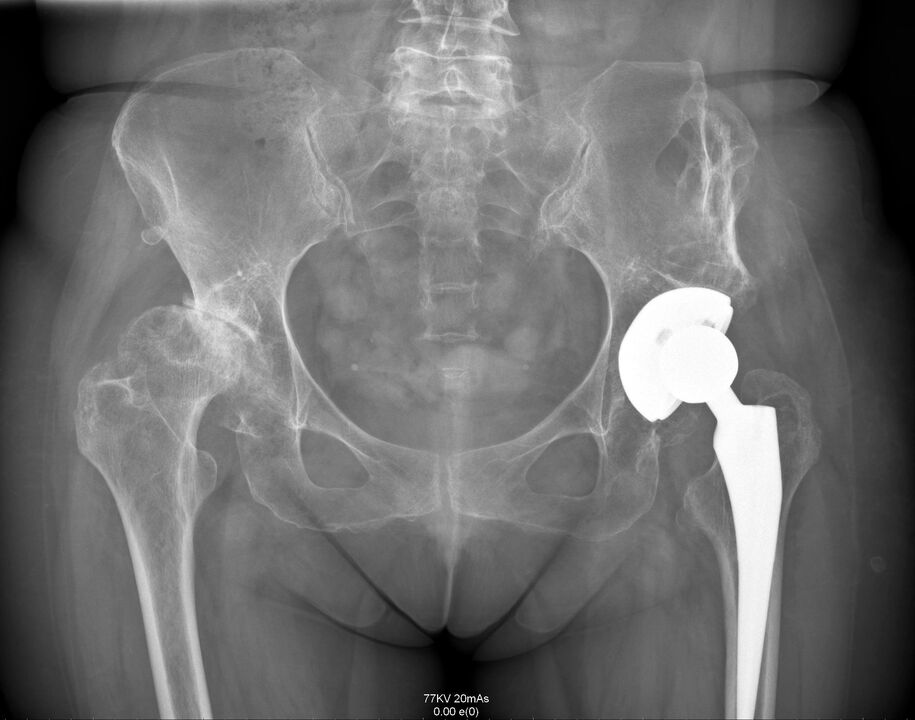
The operation is performed under general anesthesia and takes about an hour. Depending on the severity of the degenerative-dystrophic process, the operation can be performed by one of the following methods:
- surface - involves grinding of the acetabulum and the head of the femur with additional coating with smooth implants replacing the destroyed hyaline cartilage (the method is rarely used due to the possibility of inflammation in the periarticular tissues);
- unipolar - removing the femoral head and replacing it with an endoprosthesis (used when the cartilage on the surface of the acetabulum is preserved and only when the femoral head is destroyed);
- bipolar - similar to the previous technique, it differs only in the design of the used endoprosthesis, which has a lower friction coefficient and provides smoother movements in the joint bed;
- is the most effective and safe way to solve the problem of coxarthrosis of the total hip joint, which involves a complete resection of the femoral head with the capture of a part of the neck, as well as the acetabular fossa and their replacement with a full-fledged artificial one. articular joint.
Thus, patients may be advised to install different types of endoprostheses. Most hip prostheses are manufactured in the United States and England. Chemically and biologically inert metals are used for their production: cobalt, chromium, titanium alloys. Ceramics are also often used. In most modern models, polymer cushions are additionally used, which allows artificial TBS to provide natural shock-absorbing, stabilizing and sliding properties.
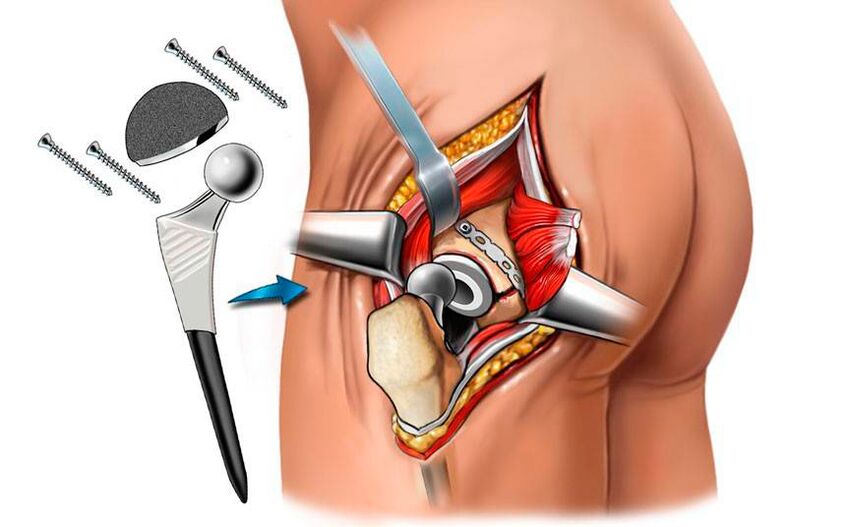
After the operation, antibiotics are prescribed to prevent the development of infectious complications, and the sutures are removed after 10 days. The size of the postoperative scar is about 8 cm. At the same time, the patient is discharged from the clinic. Rehabilitation after endoprosthetics is simple, but still requires physiotherapy, massage and exercise therapy.
osteotomy
Osteotomy is a surgical intervention that is a temporary measure before a cardinal replacement of the hip joint with an artificial endoprosthesis. The essence of the operation is to adjust the axis of the femur due to its intentional fracture. The resulting fragments are placed in the most suitable position, thereby slightly loosening the patient's joint. As a result, it is possible to temporarily reduce the severity of pain and improve mobility.
Thus, coxarthrosis of the hip is a very scary disease that can completely deprive a person of the ability to move independently. It lasts for a long time and its symptoms, especially in the initial stage, are often considered by patients as a normal condition after physical exertion. But this is the insidiousness of the disease, because it can be fought non-surgically only at the initial stage of its development. However, if the degenerative-dystrophic process has already completely destroyed the hyaline cartilages and caused the bone surfaces to be exposed and their flattening, only surgical intervention can help the patient. Fortunately, the modern level of medicine and surgery makes it possible to achieve a complete restoration of the normal state of the hip joint and its functions, in particular.
































